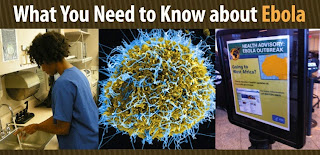A New Twist in the Ebola Epidemic Saga
A
New Twist in the Ebola Epidemic Saga
By
E. Stanley Ukeni
It is rather unfortunate that just as West Africans
are about to breathe a collective sigh of relieve regarding the abatement of
the Ebola Virus Disease pandemic, disturbing information emerged, from the
United States’ Center for Disease Control, that a previously infected US
citizen who was subsequently declared free of Ebola have been found to still
have traces of the virus in his system.
A case report from attending doctors at Emory
University Hospital in Atlanta, USA confirms that an American doctor, Ian
Crozier, who had contacted the Ebola Virus Disease in 2014 while working at a hospital
in Sierra Leone, and was subsequently evacuated to Emory University Hospital
where he was successfully treated for Ebola infection.
We have learnt that, upon his recovery from the symptoms
of the infection, Dr. Ian Crozier’s blood was thoroughly screened for the
presence of the Ebola virus in his body, before he was declared free of the
pathogen, and subsequently discharged from hospital in October of last year.
The case report indicates that about two months
after his initial discharge from hospital, Dr. Ian Crozier returned to the same
hospital where he was previously treated for Ebola infection. This time, he was
complaining of eye problems. He was referred to Emory Eye Center for further
evaluation and treatment.
In the process of medical forensic investigation of
his symptoms, the ophthalmologists at Emory University School of Medicine—who
were treating him, stuck a needle in his eyes and retrieved some fluids for
medical biopsy. The tests of the ocular fluids taken from Dr. Ian Crozier’s
eyes indicated a positive presence of the Ebola Virus in his ocular fluids—long
after the virus had been cleared from his blood. In essence, Dr. Crozier’s
biopsy showed that the Ebola Virus is still actively present in his eyes, even
though the pathogen is no longer present in his blood.
In light of this current discovery and disclosure by
the medical team at Emory University Hospital, West African epidemiologists
need to revisit the certification process for declaring an Ebola infected
individual free of the disease.
While we must
all guard against irrational panic, our health providers and emergency medical
responders need to equally ensure that the broader citizenry of ECOWAS States
are not unduly put at risk by a flawed declaration that Ebola survivors are
medically sound to reintegrate into society. I have a sense that new panic amongst
policy makers in various ECOWAS countries is probably quietly brewing over this
new revelation.
In other to alley this fear, infrastructure and
procedures need to be quickly deployed to further screen all Ebola disease
survivors—with particular emphasis on the eyes. This is necessary so as to
ensure that these already traumatized people are not, in essence, unwitting
vectors in the transmission of this deadly disease.
It is important that ophthalmologists across West
Africa need to be promptly equipped with effective and inexpensive methods for
screening the eyes of Ebola survivors. The equipment needed for effective ocular
screening should be quickly deployed to medical facilities across the West
African sub-region.
The governments of all Ebola affected counties
should strongly consider creating a dedicated database of names and medical
information of all Ebola survivors, and the whereabouts of these individuals
effectively monitored by their relevant government institutions. The database
should be managed by the WHO to ensure its integrity. Information on these
survivors should be made available to nations should information to enhance
their disease surveillance procedures. All those who receive ocular screening
can effectively be removed from the list, so as to avoid needless profiling of
persons at border posts.
Ophthalmologists and other medical responders must
also remember to continue to follow Ebola Safety Protocols when treating Ebola
survivors. This caution goes particularly to eye doctors. You can find
information on safety protocols at the following link; http://www.cdc.gov/vhf/ebola/healthcare-us/hospitals/infection-control.html
In conclusion, Dr. Russell Van Gelder, of the
American Academy of Ophthalmology, said; “This remarkable case now demonstrates
that the virus can remain viable in ocular fluids long after the patient has
recovered from the systemic infection.”
He continues, “If the Ebola epidemic continues,
ophthalmologists throughout the world will be seeing patients with post-Ebola
Uveitis (inflammation), and will need to recognize and treat this condition.”
Dr. Van Gelder concluded that, “However, I want to
emphasis that as far as we know, the Ebola virus in not transmitted by casual
contact. The current study does not suggest that infection can be transmitted
through contact with tears of patients who have recovered from their initial
infection.”
I still
maintain that, even with Dr. Russell Van Gelder caution, it’s better to be
prepared for the worse than be caught off guard.
Authored by E. Stanley Ukeni, ©2015. All Rights
Reserved.
Photograph courtesy of the US CDC





Comments
Post a Comment